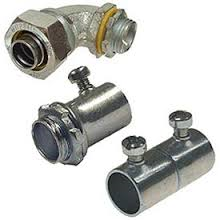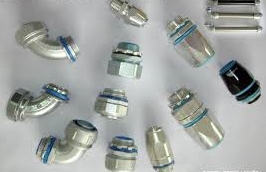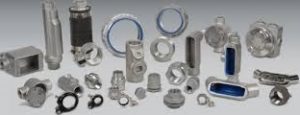


Box connectors join conduit to a junction box or other electrical box. A typical box connector is inserted into a knockout in a junction box, with the threaded end then being secured with a ring (called a lock nut) from within the box. The other end of the fitting usually has a screw or compression ring which is tightened down onto the inserted conduit. Fittings for non-threaded conduits are either secured with set screws or with a compression nut that encircles the conduit. Fittings for general purpose use with metal conduits may be made of die-cast zinc, but where stronger fittings are needed, they are made of copper-free aluminum or cast iron.
Couplings connect two pieces of conduit together.
Sometimes the fittings are considered sufficiently conductive to bond (electrically unite) the metal conduit to a metal junction box (thus sharing the box’s ground connection); other times, grounding bushings are used which have bonding jumpers from the bushing to a grounding screw on the box.
Box konektor disambung ke kotak persimpangan conduit atau kotak listrik lainnya. Sebuah konektor kotak khas dimasukkan ke dalam sistem , dengan ujung berulir kemudian diamankan dengan cincin (disebut mur pengunci atau LOCK NUT) dari dalam kotak
Ujung pas biasanya memiliki sekrup atau kompresi cincin yang diperketat ke conduit. Fitting untuk saluran non-threaded yang baik dijamin dengan sekrup set atau dengan kacang kompresi yang mengelilingi saluran tersebut. Fitting untuk tujuan umum dengan saluran logam dapat dibuat dari seng die-cast, tapi di mana alat kelengkapan kuat diperlukan, mereka terbuat dari aluminium tembaga bebas atau besi cor.
Kopling menghubungkan dua buah saluran bersama-sama.
Kadang-kadang fitting dianggap cukup konduktif untuk obligasi (elektrik bersatu) conduit logam ke kotak persimpangan logam (sehingga berbagi koneksi tanah kotak ini); kali lain, ring grounding yang digunakan yang memiliki jumper ikatan dari bushing untuk sekrup landasan pada kotak.

